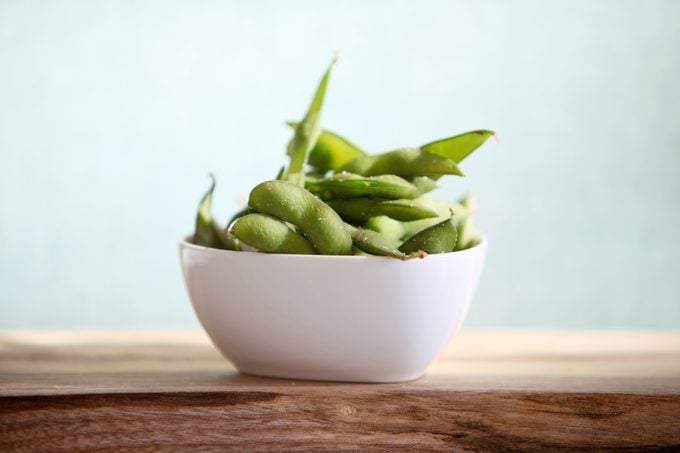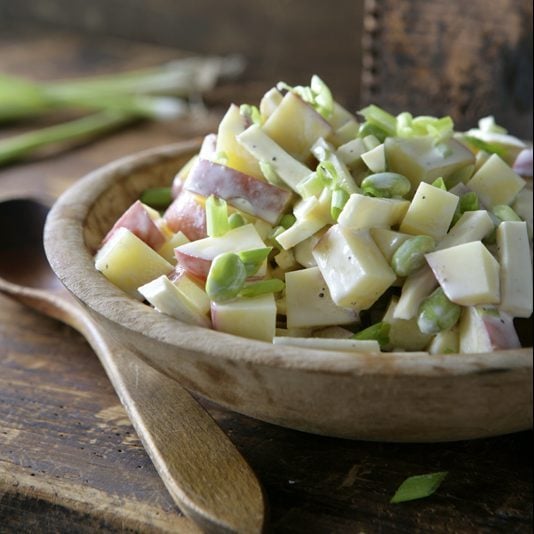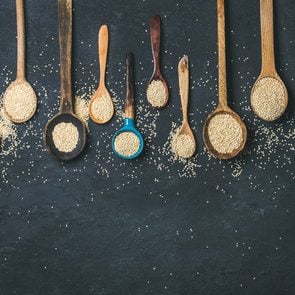Edamame—a Soybean That’s Surprisingly Healthy
Updated: Jun. 28, 2021
Want to include more plant-based protein in your diet? Say hello to edamame. This healthy legume can even help with weight loss. Learn more about the soybean's benefits.
Our editors and experts handpick every product we feature. We may earn a commission from your purchases.
On This Page
The appeal of edamame
Whoever said you shouldn’t play with your food clearly never tried edamame. Not only are these little guys fun to pop out of their pods, but they’re also sweet, delicious, and all-around great for you.
“If you’re a vegan, vegetarian, or are interested in adding more plant foods to your diet, then give edamame a try,” says Liz Weiss, registered dietitian nutritionist in Lexington, Massachusetts, and host of “Liz’s Healthy Table” podcast.
Whether you’re already an edamame eater or find yourself curious about the tasty soybeans, dietitians want you to know some key nutrition facts. Keep reading to find out what they are.
What is edamame?
Think of edamame as baby soybeans. Unlike their hard, yellow elders, edamame are harvested while they’re still soft and green. Yet, like soybeans, they’ve practically been around forever.
Edamame were cultivated in China as far back as 7,000 B.C. From there, they made their way to Japan, where they earned their name.
“The word ‘edamame’ literally means ‘stem beans’ because they were originally sold still attached to their stems,” explains Weiss. Though you won’t find them attached to their stems anymore, the name has stuck.
Even though they’ve been around for centuries, it wasn’t until the 1980s, when Americans developed an appetite for sushi, that edamame started to pop up in restaurants in the United States.
Types of edamame
Today, you can find edamame just about anywhere you shop for food, from supermarkets to big box stores—even drug stores. And it’s not just in the produce section either. These beloved legumes have infiltrated practically every section of the grocery store.
Here’s where you’ll find them:
- The frozen food aisle. Whether you love convenience or are worried about fresh produce going bad before you can eat it, one of the easiest ways to get edamame is to buy it frozen and pre-shelled. (You can also find it frozen in pods.)
- The snack aisle. “Usually packaged snack foods don’t have a very healthy reputation, but roasted edamame are different,” explains Weiss. “They pack a powerful protein punch and are often made from a short, easy-to-pronounce ingredient list of soybeans, salt, seasonings, and vegetable oil.”
- The refrigerator case. Here you’ll find edamame dip and hummus. Pureed edamame makes a rich, creamy, nutritious spread.
- The pasta aisle. Yes, edamame pasta is a thing. Not only is it gluten free, but it’s also packed with fiber and protein—12 and 24 grams, respectively, per two-ounce serving!
Edamame calories, carbs, and nutrition details
Edamame deliver a lot of nutritional punch for the calories—but note that edamame carbs are significant if you’re trying to follow a low-carb plan. Here are the nutritional details for a cup of cooked edamame:
Calories: 224
Fat: 12 g (15 percent of the daily recommended value, or DV)
Saturated fat: 2 g (10 percent DV)
Sodium: 205 mg (9 percent DV)
Carbohydrates: 14 g (5 percent DV)
Fiber: 8 g (29 percent DV)
Protein: 19 g (38 percent DV)
Folate: 458 ug (115 percent DV)
Calcium: 98 mg (8 percent DV)
Iron: 4 mg (22 percent DV)
Potassium: 675 mg (14 percent DV)
Magnesium: 99 mg (24 percent DV)
Zinc: 2 mg (18 percent DV)
Superior plant protein
“Edamame provide complete protein, which is unusual for a vegetable, as most plant foods contain incomplete protein,” says Weiss. That’s important because complete protein delivers all nine of the essential amino acids the body needs to synthesize its own protein supply.
Incomplete proteins, by comparison, lack one or more essential amino acids, making them somewhat less efficient.
An easy source of fiber
Even though soy foods get high marks for protein, not all of them contain fiber. (Soy milk, anyone?) Edamame, on the other hand, are packed with it.
“As important as fiber is, most of us are falling short of the respective 25 to 35 grams women and men need each day,” says Cara Harbstreet, registered dietitian in Kansas City, Missouri. “That’s important because fiber can support a healthy GI tract, which plays a key role in overall immune health, and may also help lower cholesterol.”

Health benefits of edamame
Despite edamame’s stellar nutrition pedigree, there’s been a lot of confusion—and misinformation—surrounding the bean’s impact on heart health and cancer.
Heart health
For years, soy foods—like edamame—were believed to do great things for the heart. Experts considered the benefit so great that in 1999 the Food and Drug Administration (FDA) gave food companies permission to claim that foods containing at least 6.25 grams of soy protein per serving could help prevent heart disease.
But in 2017, the FDA changed direction, citing concerns about research inconsistencies. As a result, it proposed revoking the claim and replacing it with a “qualified health claim” that would require a blurb mentioning the limited nature of the evidence.
Right now, the issue is still in limbo, so if you’re confused you’re hardly alone.
“The FDA isn’t claiming that soy protein doesn’t lower blood cholesterol, but rather the evidence supporting its cholesterol-lowering effect isn’t as consistent as it once was,” says Toby Amidor, a registered dietitian in Scarsdale, New York, and author of The Best 3-Ingredient Cookbook.
Considering edamame are naturally low in saturated fat, contain zero cholesterol, and are packed with isoflavones believed to protect against cardiovascular disease, they’re an extremely heart-healthy food.
Breast cancer
Because soy’s isoflavones also act like estrogens, some people have made the leap to claim edamame might cause breast cancer. “The myth that soy can lead to breast cancer began with several animal studies in the 1990s,” explains Amidor.
But does that translate to humans? “There’s substantial evidence that debunks this myth, and some studies show it may even have a protective effect,” she says.
Weight loss
If you’re looking to lose weight, edamame are a great addition to your meal plan. With only 140 calories per 100 grams, it beats a lot of snack food options, even healthier choices like mixed nuts. For comparison, the same serving of potato chips has 536 calories, while a serving of mixed nuts has 607 calories.
“For people trying to manage their weight, it’s important to seek out ingredients that provide fiber, keep you feeling full and satisfied, and also bring interest and flavor to meals,” says Weiss. “Edamame deliver. In addition to being low in calories and high in filling fiber, they have a soft, slightly chewy texture, so they may help you slow down as you eat and truly savor every bite.”
You can replace high-calorie, high-fat, nutritionally lacking junk food with these nutrient-packed soybeans. You’ll certainly stay full longer after snacking on these beans than candy or chips.
Edamame risks and side effects
Of course, edamame are no-go if you’re allergic to soy. Luckily, very few adults have this allergy. According to a 2019 JAMA Network Open study of 40,443 adults, only 0.6 percent were allergic to soy, less than almost any other major food allergen.
If you’re on a low-carb diet, you’ll want to keep in mind that a cup of edamame has 14 grams of carbs. That’s not a ton (they have fewer carbs than chickpeas, for instance), but if you’re following a low-carb diet, you may want to eat the soybeans in smaller quantities.
Are there other reasons to avoid the beans? Not really, says Harbstreet. The biggest side effect might be gas and bloating if you’re not used to their fiber. “This shouldn’t deter you from eating them, especially if you enjoy the flavor, nutrition, and convenience they offer,” she says. Starting with small servings can give your digestive system time to adjust.
What about their lectins?
“Aside from the misconception that edamame should be avoided by men, lectins are the second most commonly cited reason for avoiding edamame and beans when I talk with my clients,” says Harbstreet. They’re compounds in healthy foods like beans, legumes, and pulses that bind to some carbohydrates, potentially tying up some nutrients in the process.
So is the presence of lectins a good reason to skip edamame? Not really.
“The truth is, lectins are generally deactivated during soaking and cooking,” she says. Considering no one would recommend eating uncooked edamame, their lectins shouldn’t be a concern.
How to eat edamame
Edamame are incredibly versatile. Try them as a spicy snack, or toss them into soup, pasta, or a noodle bowl. Check out these edamame recipes for more snack and meal ideas.
They’re also delicious in salads like Amidor’s Potato Salad with Parsnips and Edamame. Here’s the recipe below.

Potato Salad with Parsnips and Edamame
6 servings
Ingredients
1 pound red potatoes
8 ounces parsnips
1/2 cup frozen shelled edamame
2 medium scallions
3 tablespoons light mayonnaise
3 tablespoons nonfat plain Greek yogurt
1 tablespoon low-sodium soy sauce
1 tablespoon rice vinegar
1/2 teaspoon salt
1/4 teaspoon freshly ground black pepper
Instructions
- Cut the potatoes into 1/2-inch cubes. Peel the parsnips and cut into 1/4-inch-thick slices. Pour 1/2 cup water into a medium pot fitted with a steamer basket and bring to a boil over high heat. Add the cubed potatoes and sliced parsnips, cover the pot, and lower the heat to medium. Cook until the vegetables are tender, about 10 minutes. Remove from the pot and set aside to cool for at least 10 minutes.
- Fill the same pot (without the steamer basket) with water and bring to a boil over high heat. Add the edamame and lower the heat to medium. Cook for about 5 minutes, until heated through. Drain and set aside to cool for 5 minutes.
- In a large bowl, combine the cooled potatoes, parsnips, and edamame.
- Chop the scallions, both whites and greens. In a medium bowl, whisk together the chopped scallions, mayonnaise, yogurt, soy sauce, vinegar, salt, and pepper. Add this dressing to the potatoes mixture and mix gently to combine.
Per 1-cup serving: 145 calories, 3 grams fat, 1 gram saturated fat, 3 milligrams cholesterol, 4 grams protein, 25 grams carbohydrate, 5 grams sugar, 4 grams fiber, 358 milligrams sodium




















